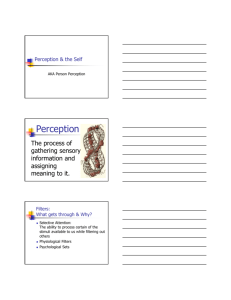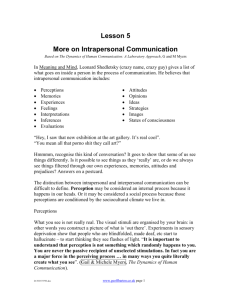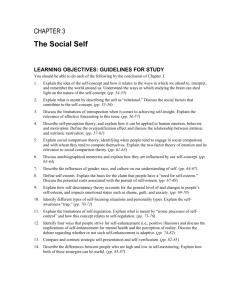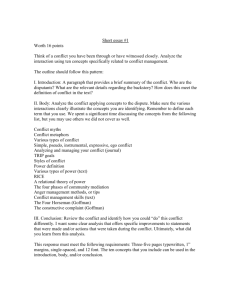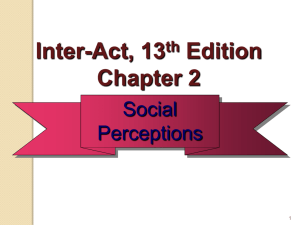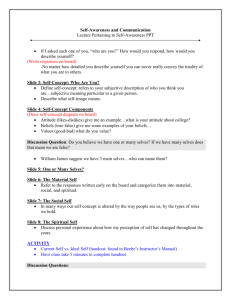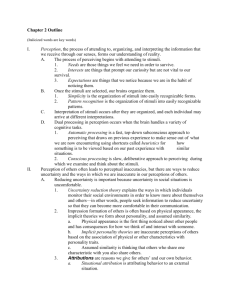Note Lecture -- "perception" By S. Bradshaw
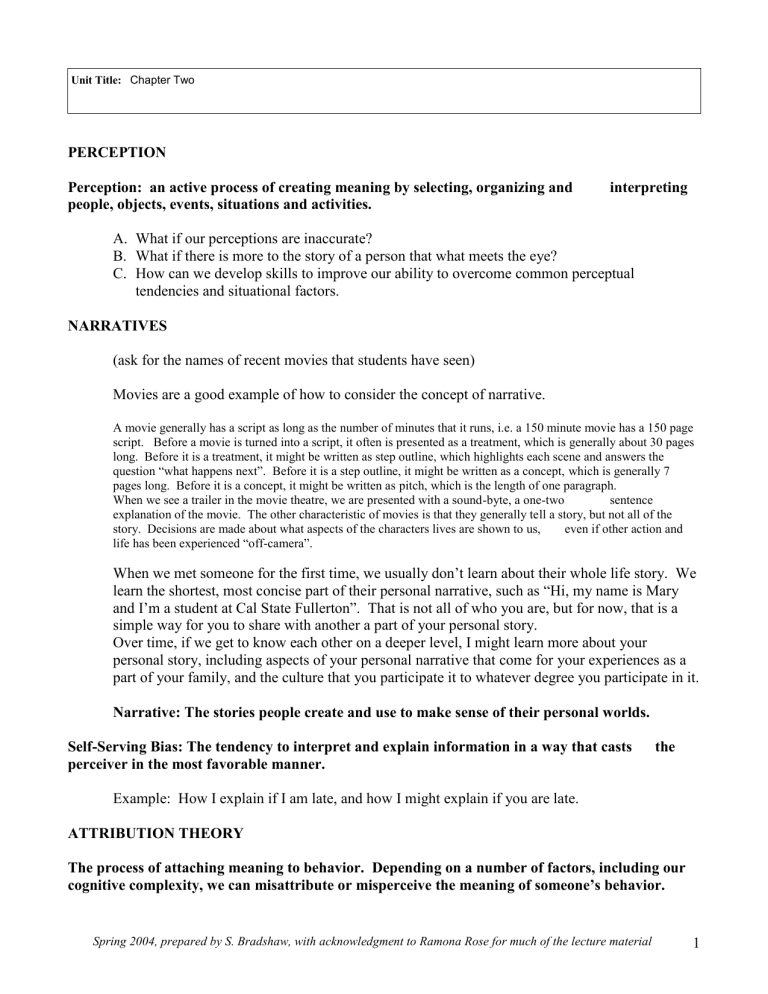
Unit Title: Chapter Two
PERCEPTION
Perception: an active process of creating meaning by selecting, organizing and interpreting people, objects, events, situations and activities.
A.
What if our perceptions are inaccurate?
B.
What if there is more to the story of a person that what meets the eye?
C.
How can we develop skills to improve our ability to overcome common perceptual tendencies and situational factors.
NARRATIVES
(ask for the names of recent movies that students have seen)
Movies are a good example of how to consider the concept of narrative.
A movie generally has a script as long as the number of minutes that it runs, i.e. a 150 minute movie has a 150 page script. Before a movie is turned into a script, it often is presented as a treatment, which is generally about 30 pages long. Before it is a treatment, it might be written as step outline, which highlights each scene and answers the question “what happens next”. Before it is a step outline, it might be written as a concept, which is generally 7 pages long. Before it is a concept, it might be written as pitch, which is the length of one paragraph.
When we see a trailer in the movie theatre, we are presented with a sound-byte, a one-two sentence explanation of the movie. The other characteristic of movies is that they generally tell a story, but not all of the story. Decisions are made about what aspects of the characters lives are shown to us, even if other action and life has been experienced “off-camera”.
When we met someone for the first time, we usually don’t learn about their whole life story. We learn the shortest, most concise part of their personal narrative, such as “Hi, my name is Mary and I’m a student at Cal State Fullerton”. That is not all of who you are, but for now, that is a simple way for you to share with another a part of your personal story.
Over time, if we get to know each other on a deeper level, I might learn more about your personal story, including aspects of your personal narrative that come for your experiences as a part of your family, and the culture that you participate it to whatever degree you participate in it.
Narrative: The stories people create and use to make sense of their personal worlds.
Self-Serving Bias: The tendency to interpret and explain information in a way that casts the perceiver in the most favorable manner.
Example: How I explain if I am late, and how I might explain if you are late.
ATTRIBUTION THEORY
The process of attaching meaning to behavior. Depending on a number of factors, including our cognitive complexity, we can misattribute or misperceive the meaning of someone’s behavior.
Spring 2004, prepared by S. Bradshaw, with acknowledgment to Ramona Rose for much of the lecture material 1
Examples: A child misinterpreting that a parent is unhappy with them when they are not smiling. A young adult misinterpreting friendliness as “interest” in another. All manner of trying to assign meaning to other’s behavior without knowing what the underlying intention or meaning is to the behavior.
EXPECTANCY VIOLATION THEORY
Expectations held by individuals, shaped by culture … guidelines for human conduct for how others will behave (Burgoon, 1978).
Examples: Verbal and nonverbal (eye contact, proxemics) as situational factors that we discussed that play a role in our perceptions of others.
\
Physical affection (hugging, kissing) in males in some European cultures. In the U.S., males in some cultures hug and kiss (Greek Americans, Armenian Americans, Italian Americans, others???)
ETHICS
Ethics judged by the situation
Defined: the view that the "right solution to any moral problem depends much more on the situation itself than on any general, external code: and that the key to the solution is always love"
Philosophers have developed different frameworks for considering ethics
1.
Kant
2.
Aristotle
COMMUNICATION COMPETENCE
A.
Communication competence
1.
no one, ideal way
2.
situational
3.
relational
4.
can be learned
5.
Why don’t' we see children arguing in front of the Supreme Court?
B.
Aspects of competent communicators that we are focusing on in this chapter:
1.
Mindfulness
2.
Empathy/perspective taking
3.
Self-monitoring
4.
Belief in the dignity of others
5.
Belief in an ethical framework
GOALS FOR THIS CHAPTER FROM HAROLD BLOOM'S TAXONOMY OF
EDUCATIONAL OBJECTIVES:
A.
Application - YOU CAN USE IT
1. Attitude: Mindfulness
2. Skill: Perception checking
3. Belief: Dignity of others, commitment to an ethical framework
Spring 2004, prepared by S. Bradshaw, with acknowledgment to Ramona Rose for much of the lecture material 2
PERCEIVING OTHERS
A. Discussion of perception of others activity
B. Definitions of empathy, sympathy, face, facework, presenting self, impression management.
Impression management: the communication strategies people use to influence how others view them.
Perceived self : a reflection of the person you believe yourself to be in moments of honest selfexamination. o This self is made up of things like your appearance, intelligence, talents, and social skills.
Presenting self : your public image—your public “face.” o Usually the socially approved image: diligent student, loving partner, nurturing parent, conscientious and cooperative co-worker. o If face is the presenting self , then facework is the verbal and nonverbal ways we act to maintain our own presenting image and the images of others .
Why do we manage impressions?
Because social rules govern the proper way to behave, and knowing such rules helps us to function successfully in society.
Managed impressions help us to accomplish our personal goals.
PERCEIVING THE SELF
A. Self-concept activity: Where do our self-concepts come from?
B. Self concept defined: A set of relatively stable perceptions that each of us holds about ourselves.
C. What is the relationship between self-concept and self-esteem?
Our textbook example is of a person whose self-concept includes being religious, tall or athletic.
How he or she felt about these qualities: “I’m glad that I am athletic” or I’m embarrassed about being so tall” would affect our evaluations of our self-worth or self-esteem.
D. Reflected appraisal or looking-glass self: Each of us develops a self-concept that mirrors the way we believe others see us. We learn our self-concepts through our interactions with others.
How do people respond to us? What do the significant people in our lives – parents, siblings, teachers, peers, reflect back to us?
E. Social comparison: Evaluating ourselves in comparison to others. Example: Peer influence and comparison to what the popular kids are doing in smoking/non-smoking schools.
Are we better or worse compared to others? Depends on who you measure yourself against. We need to choose a reasonable standard.
Not all aspects of self are influenced by others. Can you give an example? Examples: height, national origin, hair color, shyness (nature/nurture).
Spring 2004, prepared by S. Bradshaw, with acknowledgment to Ramona Rose for much of the lecture material 3
How many of you would like to change something about your body or physical appearance?
(show of hands).
How many of you have changed something about yourself because of the influence of others?
Examples: hair style, color, clothing, cologne, weight.
How much control can we have over our own self-concept? Can we shape or reshape our perception of self?
Our self concept is subjective. Remember that even though we tend to judge ourselves more favorably than others, we often view ourselves in harsher terms than others view us. We are our own worst critics. Imagine, then, just how unfavorable we must view others?
Our self-concept can become distorted.
Examples: Obsolete information such as past failures or successes
Example: Worry about public speaking – sensitizers, need to change the way that you link past failure with future performance.
Our self-concept is not always accurate because of distorted feedback:
Examples: Overabundance of negative feedback when young, or an undisciplined child who can do no wrong; manager who is schmoozed by employees but is a poor manager; emphasis on selfverification, seeking out others who will confirm our self-concept.
Dígame quién usted corre con y yo lo diré quién usted es
Tell me who you run with and I’ll tell you who you are.
Research has shown that individuals with low self-esteem are more easily persuaded than individuals with high self-esteem.
People with low self-esteem are: o usually critical of themselves and others; o expect to be rejected for who they are; o work better under less demanding managers; o do poorly when being watched; o are threatened by people they view as superior; o do not defend themselves well against others—they usually accept negative comments about themselves from others.
People with high self-esteem are: o less critical of themselves and others; o expect to be accepted by others; o work better for those who demand high standards; o do well when watched; o are usually comfortable with others they view as superior; o are able to defend themselves verbally.
How much does our culture affect our self-concept? Our entire notion of the self is shaped by the culture in which we have been raised.
Spring 2004, prepared by S. Bradshaw, with acknowledgment to Ramona Rose for much of the lecture material 4
The most observable feature of a culture is the language that its members use. A member of a minority group may feel as if they are not part of the majority group, but are part of the “outgroup” because their primary language is not the same as the majority.
Members of cultural minorities feel pressure to conform while at the same time wanting to hold on to their personal cultural identities.
Personality and self-fulfilling prophecy . Personality is defined as a relatively consistent set of traits people exhibit across a variety of situations. Self-fulfilling prophecy occurs when an individual’s expectations about an event make the outcome more likely to occur than would otherwise be true .
There are two types:
Self-imposed prophecies—these take place when our own expectations influence our behavior.
Other-imposed prophecies—these take place when others’ expectations influence our behavior.
If a parent continually tells a child that he/she can do nothing right, then that child’s self-concept will eventually reflect that assertion.
A child who is told they can succeed has a much higher chance of succeeding.
Ways to improve our perception skills.
1. Link details with the big picture.
Skilled perceivers keep the big picture in mind as they look for clues about a person. Don’t rush to judgment based on a few bits of information.
2.
Become aware of others’ perceptions of you.
Seek out feedback. It is difficult to be objective about our own behavior, so feedback from others is critical to our self-perceptions.
3. Increase your awareness.
Consciously attend to the input you are receiving when interacting with others. Try to identify one new thing each time to focus on and observe. Watch gestures, eyes, foot movements; listen to tone of voice. While noticing as much detail as possible, keep the entire picture in view.
4. Become other-oriented. Can someone explain what e mpathy is? (Example: walk a mile in someone’s shoes.) Effective interpersonal perception depends on the ability to understand where others are coming from, to take on their viewpoint—their perspective.
5. Check your perceptions. Check the accuracy of your perceptions.
DEFINITION— Indirect perception checking: Seeking additional information to confirm or refute interpretations you are making through passive perception such as observing and listening.
DEFINITION— Direct perception checking: Asking for confirmation from the observed person of an interpretation or a perception about him or her.
There are 3 parts to perception checking:
1.
A description of the behavior you noticed
2.
At least two possible interpretations of the behavior
3.
A request for clarification about how to interpret the behavior
Spring 2004, prepared by S. Bradshaw, with acknowledgment to Ramona Rose for much of the lecture material 5

